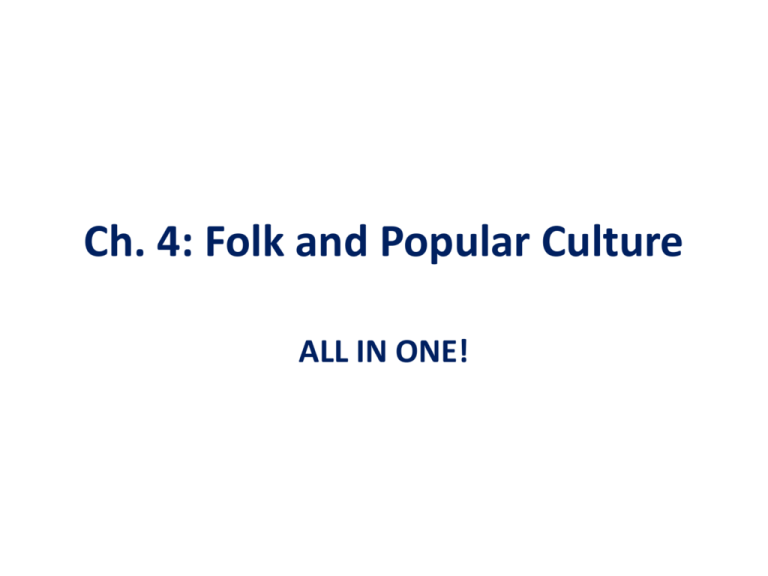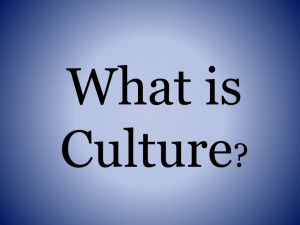File
advertisement

Ch. 4: Folk and Popular Culture ALL IN ONE! Culture • The combination of: – Material Culture/constructed artifacts • Art, houses, clothing, sports, dance, foods • This chapter deals with material artifacts – Nonmaterial Culture • Language (Ch. 5) • Values- religious beliefs (Ch. 6), ethnicity (Ch. 7) • Political institutions (Ch. 8) Material Culture • Two basic categories: folk/local and popular culture – Folk/local culture • Usually practiced by small, isolated, homogeneous groups in rural areas where tradition dominates life and they are resistant to change – Popular culture • Characterized by large, heterogeneous groups of people who share common habits despite differences in other personal characteristics Folk Cultures in US Where Do Cultures Originate? • Origin of folk and popular cultures – Folk culture = hearth area/originators are usually unknown – Popular culture = hearth area comes from more developed countries (MDCs) • People in MDCs have disposable income and leisure time that allow for use of new innovations – Golf, cars, gaming systems, TVs etc. Where Do Cultures Diffuse? • Diffusion of folk and popular culture – Folk culture diffuses slowly, primarily through migration, and at a small scale; clustered • Example: Diffusion of Amish culture- what role does the environment play? – Popular culture diffuses rapidly, mostly via hierarchical diffusion, and over a large scale • Example: Sports, fashion Hierarchical diffusion: $65,000 to $3500 in 48 hours! Diffusion of Pop Cultures • Rapid diffusion (through globalization) reduces the local diversity of folk cultures (i.e. their customs). • Pop culture vs. folk/local cultures = Globalization vs. local diversity Globalization vs. Local Diversity How are local cultures sustained? • By clustering • By being isolated • By practicing customs/traditions in the face of globalization Influence of the physical environment –Folk culture = close connection to the environment • Most folk cultures are rural and agricultural –Clothing is often tied to environmental conditions »Example: Wooden clogs in the Netherlands Food Preferences • Terroir- effects of local environment on food (soil’s effect on wine) • Folk- certain foods eaten because of natural properties • See case study for examples • Food customs are affected by availability of products worldwide • Food preferences are adapted to the environment • In Asia, rice is grown in milder, wetter environments; wheat is grown in colder, drier environments Food Preferences • Food taboos may be especially strong – People avoid certain foods because of negative associations with that food – Preferences developed for environmental (protect endangered animals) and cultural (religion) reasons – Examples- no pork for Jews or Muslims; popular culture doesn’t eat bugs like some folk cultures do – Coca Cola Some Kosher Laws- Of the "beasts of the earth" (which basically refers to land mammals with the exception of swarming rodents), you may eat any animal that has cloven hooves and chews its cud. Any land mammal that does not have both of these qualities is forbidden. • All blood must be drained from meat and poultry or broiled out of it before it is eaten. • Fruits and vegetables are permitted, but must be inspected for bugs • Grape products made by non-Jews may not be eaten • Meat (the flesh of birds and mammals) cannot be eaten with dairy. Fish, eggs, fruits, vegetables and grains can be eaten with either meat or dairy. (According to some views, fish may not be eaten with meat). • Utensils (including pots and pans and other cooking surfaces) that have come into contact with meat may not be used with dairy, and vice versa. • Utensils that have come into contact with non-kosher food may not be used with kosher food. This applies only where the contact occurred while the food was hot. Swine Stock Figure 4-8 Reterritorialization of Pop Culture • Certain aspects of pop culture (music, food) will take on new forms when presented in new places – Reterritorialization- Taking something not from your “territory” and re-making it so it becomes unique to only your “territory” • Reterritorializatoin of Hip Hop- Example of reverse hierarchical diffusion (inner cities to global) • European Hip Hop in France and Germany mixed with local cultures, experiences, and places making it unique to each locale • Sampling/mixing things from own culture into Hip Hop music Why Is Popular Culture Widely Distributed? • Remember: Pop culture requires disposable income and leisure time –Popular culture varies more in time than place Explain what we mean when we say that popular culture varies more in time than in space. Differentiate this from what you know about folk culture. Losing the Local? • Pop culture itself can seem like an assimilation policy • US, West Europe, Japan, South Korea, India are all hearths of pop culture that produce different aspects of pop culture • French radio policies- (saving the local) Assimilation v. Acculturation • Acculturation (still has the word culture in it!) – Minority culture adopts traits of major culture but KEEPS most of their own beliefs – Occurs when local culture lives among members of the major culture and ACCEPT certain aspects of major culture • Assimilation – Minority culture learns and absorbs major culture to the point that the original culture IS LOST – Minor culture comes to resemble the major group; makes acceptance easier AcculturationAdopt traits, but keeps own, too. AssimilationAdopted traits “take over” Assimilation v. Acculturation • Examples: – Second-language learning at school, but speaks first language at home still – Sushi becoming popular in US – Naturalization process for immigrants – Immigrant parents choosing “American” names for children – Forcing Native American’s in Boarding Schools and forbidden to speak language Clash of Cultures (Pop vs Folk/Local) • Local cultures try to: – Keep other cultures out, Keep own culture in – Avoid cultural appropriation – when other cultures adopt customs and knowledge and use them for own benefit • Commodifying local culture (Katy and Russell); Little Sweden? TOASTER STRUDEL! • Commodification- to treat something that cannot be owned or that everyone has a right to like a product that can be bought and sold Drawbacks of Cultural Appropriation • Shouldn’t it be a compliment? • Usually done for economic benefit • Commodification affects local cultures in many ways – Material and nonmaterical culture can be commodified by nonmembers – The culture itself can be commodified“observing” the Amish culture – Stereotypes / replicas mistaken for authentic • Some Amish DO use technology • Local cultures strive to make each place their own by infusing their customs, beliefs and traits into the landscape • Theme parks and other entertainment venues look to copy the “mysticism” of local cultures • Unsuspecting tourists may mistake the “mysticism” as authentic • Corporations try to commodify the mystique of local cultures to intrigue customers/make profit, Ex: Irish Pub Company/Guinness • Globalize the mystique of the traditional Irish pub • *Spain, US, Italy and France have more than Ireland Authenticity of Places • With commodification, usually one image or experience is typecast as the “authentic” image/experience of that culture. • It is that image/experience that the tourist or buyer desires. • People need to experience the complexity of a place/culture directly, rather than a stereotype of it. • An “authentic” culture is complex, not categorized or stereotyped Authenticity of Places • Commodifying local cultures freezes customs in place and time – Local cultures, both urban and rural, are touched by outside influences over the years and therefore are dynamic (always changing) • The search for an “authentic” local culture perpetuates (keeps going) the myths/sterotypes about local cultures Did these buildings ever exist this way? Did people really dress like that? Are these stereotypes of the “mystique”/uniqueness of a culture? Or are they authentic representations? Is this how the culture “characterized” here still is? Busch Gardens would love to sell you some authentic “Africa”! Am I really experiencing Mexico right now? Mulan does exist! Arendelle = Norway? No(r)way! Amish for Sale! • November 4, 2007, we purchased Flaby's Amish Tour business. We thought it would be fun to carry on Flaby's professional Amish tours. Vern, Eric, Rory, and Joan are our excellent, knowledgeable, and friendly hosts that guide the tours http://www.bluffscape.com/amish_tours.htm • “certified guides”--Unique, intimate visit to 3 Amish properties --- a farm at milking time to observe how the Amish milk cows and cool milk without electricity (oooh, aahhh) http://www.padutchcountry.com/members/amish_country_tours.a sp Commodifying a name Is this the inside of an “authentic” Irish pub or an exported copy? Am I being too critical? • Possibly. Some cultures may embrace people coming to “look at/study” them because it could educate and raise awareness. They may want/need that economic benefit. • Problems arise when: – cultural artifacts/customs/traditions are exploited (abused or misused), especially by nonmembers – We “think” we know about a culture from what has been portrayed to use by popular culture—movies, magazines, etc. • Both of these problems will lead to stereotypes and perpetuate the myths in search for the “authentic” culture Western Control of Media • West (US, GB, Jap) controls majority of media • TV programming diffuses western ideas/culture – Glorifies consumerism, violence, sexuality, and militarism • News coverage – MDCs are unlikely to focus or provide third world perspective on issues important in the LDCs. – LDCs rely on BBC, AP, and Reuters Marlboro Man in Egypt Satellites • Satellites provide a way to get banned shows from all over the world • Banned in Singapore; “un-Islamic” in Saudi Arabia Environmental Impact of Pop Culture • Modifying nature – Pop culture ignores local environment – Spatially expansive—takes up a lot of room • Golf courses Palm Springs, CA Beijing, China Beijing, China Palm Springs, CA Environmental Impact of Pop Culture • Negative Impacts – Increased demand/depletion of natural resources • Animal consumption (chicken, beef) leads to grain depletion (feed) = inefficient use of food!!! – Pollution • Pop culture produces waste (Garbage can Ghana) Environmental Impact of Pop Culture • Uniform Landscapes – Creates homogeneity • “placelessness”- loss of uniqueness of places – Product/name/brand recognition • Brings familiarity to a “strange” place – Buildings designed for recognition of function • Hotels, gas stations, grocery stores 3 ways to get “placelessness” 1. Certain planning and architectural forms have diffused around the world • Skyscrapers in downtowns 2. Businesses and products are so widespread that they leave distinctive “stamps” on the landscape of far flung places • Signs: Pizza Hut, McDonalds, etc. 3. Borrowing of idealized landscape images blurs places together • Transplanting landscape features even it doesn’t fit • Las Vegas strip #1: Skyscrapers-Petronas Towers, Malaysia #2: Business “stamps” on landscape: Munich, Germany #2: Business “stamps” on landscape: Las Vegas Strip #3: “Idealized” landscapes blur lines between places- Rialto Bridge in Venice, Italy #3: “Idealized” landscapes blur lines between places- Venetian Hotel and Casino, Las Vegas #3: “Idealized” landscapes blur lines between places- Venetian Hotel and Casino in Macau, China Surfing at Disney’s Orlando Typhoon Lagoon Are places still tied to local landscapes? Disconnect with landscape: indoor skiing/swimming pools? desert surfing? Distance Decay vs Time-space Compression • Distance decay- diffusion less likely the further from the hearth you are = slower, old method of diffusion from hearth • TSC- depends on the connectedness among places due to communication and transportation networks (world becoming smaller) = faster, modern method of cultural diffusion; no more distance decay problems? • Today, the world is as connected as ever and those without connections are even more removed







